View in other NatureServe Network Field Guides
NatureServe
Montana
Utah
Wyoming
Idaho
Wisconsin
British Columbia
South Carolina
Yukon
California
New York
Trumpeter Swan - Cygnus buccinator
State Rank Reason (see State Rank above)
Species is uncommon to rare and has a restricted breeding habitat within Montana. It suffered historic declines due to over-hunting and lead poisioning and nearly became extiinct in the lower 48. Reintroduction efforts have extablished breeding populaitons in Montana. Currently it appears stable and is facing few threats.
General Description
Trumpeter Swans are the largest waterfowl in North America. They can be up to 5 feet in length, have a wingspan up to 80 inches (almost 7 feet) and weigh over 20 pounds. Males are larger than females, but otherwise the sexes are similar in appearance. The adult Trumpeter Swan is entirely white, although the head and neck are sometimes stained an orange color due to iron-rich waters and mud where they forage for food. The webbed feet and legs are black. The bill is straight, rarely shows any yellow spot in front of the eyes (lores) and also is black. Sometimes the lower mandible shows a salmon-red line along the upper edge (Mitchell 1994). Juvenile swans are mostly white, but can retain a gray or brown head, neck and body feathers. Their feet may be yellowish, grayish or dull black. Hatchlings (cygnets) are all gray in color and have pinkish feet and a black and pink bicolored bill (Mitchell 1994).
The vocalization of Trumpeter Swans is limited to only a call sounding like "
oh-OH". They can make this call either with their mouths open (louder) or closed (nasal-like). Other sounds made include peeps, hisses and gurgles (Mitchell 1994).
For a comprehensive review of the conservation status, habitat use, and ecology of this and other Montana bird species, please see
Marks et al. 2016, Birds of Montana.Diagnostic Characteristics
Trumpeter Swans are similar in appearance to, but larger than, Tundra Swans. Trumpeter Swans rarely show any yellow on the lores, while Tundra Swans have very evident yellow lores (Mitchell 1994). The easiest method of separation between these two species is vocalization. Trumpeter Swans are less vocal, much lower pitched and have a more nasal quality than the louder, clearer sounds of Tundra Swans (Sibley 2000). Trumpeter Swans are also similar in size and weight to the introduced Mute Swans. However, the bill of Mute Swans is mostly orange rather than all black. Also, male Mute Swans have a black knob at the base of the bill. Trumpeter Swans do not have this knob (Mitchell 1994).
Species Range
Montana Range
Range Descriptions
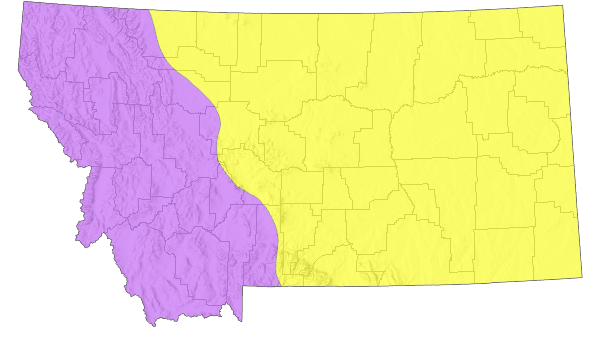 Western Hemisphere Range
Western Hemisphere Range
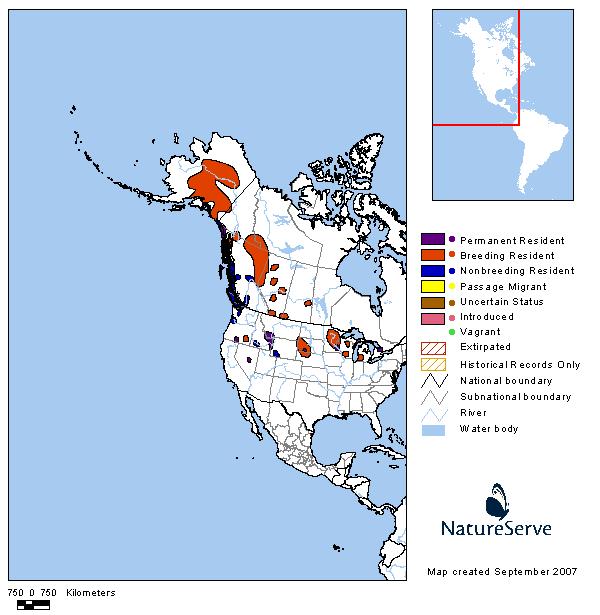
Observations in Montana Natural Heritage Program Database
Number of Observations: 8203
(Click on the following maps and charts to see full sized version)
Map Help and Descriptions
Relative Density
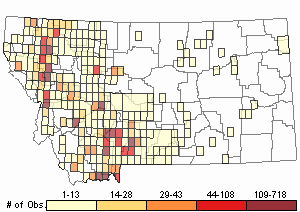
Recency
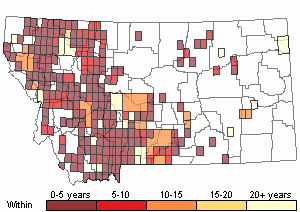
SUMMER (Feb 16 - Dec 14)
Direct Evidence of Breeding

Indirect Evidence of Breeding

No Evidence of Breeding

WINTER (Dec 15 - Feb 15)
Regularly Observed

Not Regularly Observed

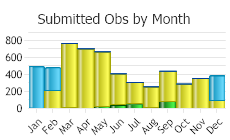
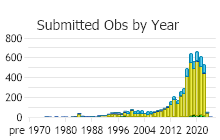
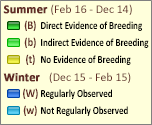 (Observations spanning multiple months or years are excluded from time charts)
(Observations spanning multiple months or years are excluded from time charts)
Migration
Trumpeter Swans breeding in Montana are non-migrants. They spend both the breeding season and the winter in southern Montana's lakes, ponds, and streams of the Red Rock Lakes National Wildlife Refuge. The Canadian subpopulation breeding in parts of British Columbia, Alberta, the Yukon, and the Northwest Territories will move south in late October to early November (Mitchell 1994).
Fall migration dates for the Bozeman area are November 15 to December 15 (Skaar 1969). They usually follow the Rocky Mountain Front moving further south as water freezes or food diminishes. They eventually arrive in southern Montana and winter along with the resident population. Canadian swans leave their wintering grounds in early March to early April, moving up the Rocky Mountain Front toward their breeding habitat further north (Mitchell 1994). Migration dates for Bozeman are February 25 to April 15 (Skaar 1969).
Habitat
The breeding habitat for Trumpeter Swans in the Red Rock Lakes/Centennial Valley of Montana includes lakes and ponds and adjacent marshes containing sufficient vegetation and nesting locations. Along the Rocky Mountain Front the breeding habitat is small pothole lakes, generally with sufficient water to maintain emergent vegetation through the breeding season (Montana Natural Heritage Program Point Observation Database). Habitat requirements for breeding include room to take off (~100 m), shallow, unpolluted water with sufficient emergent vegetation and invertebrates, appropriate nest sites (i.e. Muskrat lodges), and areas with little human disturbance (Mitchell 1994).
Their nonbreeding habitat in Montana is the many large and small lakes and ponds in extreme southern Montana, including the breeding area of the Red Rock Lakes/Centennial Valley. Trumpeter Swans also winter in the Ennis Lake and Madison River complex, as well as Hebgen Lake and the surrounding area. During winter appropriate habitat is areas where water does not freeze and food is plentiful and accessible. Trumpeter Swans will move out of one lake or pond to another if conditions become too severe.
National Vegetation Classification System Groups Associated with this Species
Wetland and Riparian
Alkaline - Saline Wetlands
Alpine Riparian and Wetland
Peatland
Riparian and Wetland Forest
Riparian Shrubland
Wet Meadow and Marsh
Food Habits
In the Yellowstone ecosystem dominant foods (over 10% in at least one season) included Chara spp. (21.7%), Elodea canadensis (11.4%), Potamogeton spp. (32.2%), and Potamogeton pectinatus tubers (15.7%) (Squires and Anderson 1995); however, Hampton (1981) reported up to 10% of food was animal matter, primarily invertebrates and fish.
Ecology
At Red Rocks National Wildlife Refuge, the population increased until 1954 and has declined steadily since, possibly due to a decrease in Elodea canadensis (Page 1976), or to lack of migration and the resultant poor nutritional gain, producing inviable eggs/young (Hampton 1981).
Reproductive Characteristics
Nesting begins in late April or early May in the intermountain western U.S. Clutch size is 2 to 9, usually about 5). In Yellowstone National Park and environs, clutch size is about 4 (Shea 1979). Incubation, mainly conducted by the female, lasts 33 to 37 days (Harrison 1978). Hatching occurs in June in the intermountain western U.S. In Yellowstone National Park, the hatching rate is approximately 49%. 54% of nests hatched at least one egg. The average brood size at hatching is 3.3 and 2.0 at fledging (Shea 1979). Nestlings are precocial but remain with adults until the subsequent spring. Fledging occurs at 100 to 120 days. Young remain with parents through winter; siblings may stay together for a few years and may rejoin parents after the nesting period. Trumpeter Swans first nest at 4 to 5 years (may form pair bonds earlier) and form a life-long pair bond. Rarely does more than one pair nest on a single body of water.
The U.S. Fish and Wildlife Service, with biannual Trumpeter Swan Surveys of the Rocky Mountain Population, monitor Trumpeter Swan reproduction in Montana closely. Since 1972, every September and February surveys are initiated across southern Montana to document the presence of Trumpeter Swans. These surveys also separate the number of white birds (adult or subadult) from gray birds (cygnets). February surveys have shown some fluctuation of the wintering swan population in Montana over the last 30 years with a record high number of 704 birds (600 white and 104 gray) in 2002 and a low of 214 birds (153 white and 61 gray) in 1995 (USFWS 2003). Overall, the wintering Rocky Mountain Population has increased drastically from about 609 birds in 1973 to over 4400 in 2002. It appears the population in Montana is remaining steady, where increasing populations in Idaho and Wyoming are the cause for the overall increase in the Rocky Mountain Population (USFWS 2003). September surveys for Trumpeter Swans have been conducted since 1967. From then up to 1992, swan numbers in the state were fairly consistent with the total number of birds ranging from 202 birds (174 white and 28 gray) in 1986 to 365 (242 white and 123 gray) in 1968 (USFWS 2001). After 1992 swan numbers in the state declined drastically. Only 76 swans (60 white and 16 gray) were recorded in 1993 and since that time the highest number of Trumpeter Swans recorded was 151 (127 white and 24 gray) in 2000 (USFWS 2001). The breeding population for the entire Rocky Mountain Population has apparently remained fairly constant over the same period of time (1967-2002). 1988 recorded a high with 658 birds recorded. The low year for breeding swans was 1993 with only 354 (USFWS 2001).
Management
Management for Trumpeter Swans began in Montana in the early 1930's with the designation of Red Rock Lakes National Wildlife Refuge (RRLNWR). This refuge was specifically created for continued Trumpeter Swan presence and for active management practices. These early management practices consisted of protection from shooting, winter feeding stations, and relocation to other breeding locations (Mitchell 1994). Some of these management activities are still in practice today, along with others including habitat restoration, human recreation management, breeding, wintering habitat management, and winter translocation work (Mitchell 1994).
Since 1988, Trumpeter Swans have been relocated from Red Rock Lakes NWR in southern Montana to locations in Idaho, Oregon, Wyoming and Utah to promote exploration of new wintering and habitats and to remedy the increasing problem of overpopulation in the refuge during winter. The goal is to have less than 10% winter at any one site and no swans winter at Red Rock Lakes NWR (Baskin 1993). In 1993, winter feeding stations were terminated in the Red Rock Lakes NWR. It was believed these stations were reducing the winter range expansion work, as birds would not actively explore new wintering locations if food were made readily available in the refuge. Since then, Trumpeter Swans have indeed dispersed to new areas in the west and the remaining population in RRLNWR has stabilized.
Other management techniques include the biannual Trumpeter Swan surveys conducted in the state, the management of Mute Swan populations, and the implementation of land-use guidelines on state, federal and provincial lands. All these practices are described and supported by The North American Management Plan for Trumpeter Swans (USFWS 1984). As noted in the distribution comments, the Confederated Salish and Kootenai Tribes in northwestern Montana are also reintroducing Trumpeter Swans on the Flathead Indian Reservation. Trumpeter Swans are a Species of Management Concern in U.S. Fish and Wildlife Service Region 6 (USFWS 1995).
Stewardship Responsibility
References
- Literature Cited AboveLegend:
 View Online Publication
View Online Publication Baskin, Y. 1993. Trumpeter swans relearn migration. BioScience 43(2):76-79.
Baskin, Y. 1993. Trumpeter swans relearn migration. BioScience 43(2):76-79. Hampton, P. D. 1981. The wintering and nesting behavior of the Trumpeter Swan. M.S. thesis. University of Montana, Missoula. 185 p.
Hampton, P. D. 1981. The wintering and nesting behavior of the Trumpeter Swan. M.S. thesis. University of Montana, Missoula. 185 p. Harrison, C.J.O. 1978. A field guide to the nests, eggs and nestlings of North American birds. Collins, Cleveland.
Harrison, C.J.O. 1978. A field guide to the nests, eggs and nestlings of North American birds. Collins, Cleveland. Marks, J.S., P. Hendricks, and D. Casey. 2016. Birds of Montana. Arrington, VA. Buteo Books. 659 pages.
Marks, J.S., P. Hendricks, and D. Casey. 2016. Birds of Montana. Arrington, VA. Buteo Books. 659 pages. Montana Natural Heritage Program. 2003. Data derived from Element Occurences with no other known source material. BIOTICS. Helena, MT.
Montana Natural Heritage Program. 2003. Data derived from Element Occurences with no other known source material. BIOTICS. Helena, MT. Page, R.D. 1976. The ecology of Trumpeter Swans on Red Rock Lakes National Wildlife Refuge, Montana. Dissertation, University of Montana, Missoula.
Page, R.D. 1976. The ecology of Trumpeter Swans on Red Rock Lakes National Wildlife Refuge, Montana. Dissertation, University of Montana, Missoula. Shea, R.E. 1979. The ecology of trumpeter swan in Yellowstone National Park and vicinity. M.S. Thesis. University of Montana, Missoula.
Shea, R.E. 1979. The ecology of trumpeter swan in Yellowstone National Park and vicinity. M.S. Thesis. University of Montana, Missoula. Sibley, D.A. 2000. The Sibley guide to birds. National Audubon Society and Alfred A. Knopf, Inc., New York, NY. 544 pp.
Sibley, D.A. 2000. The Sibley guide to birds. National Audubon Society and Alfred A. Knopf, Inc., New York, NY. 544 pp. Skaar, P.D. 1969. Birds of the Bozeman latilong: a compilation of data concerning the birds which occur between 45 and 46 N. latitude and 111 and 112 W. longitude, with current lists for Idaho, Montana, Wyoming, impinging Montana counties and Yellowstone National Park. Bozeman, MT. 132 p.
Skaar, P.D. 1969. Birds of the Bozeman latilong: a compilation of data concerning the birds which occur between 45 and 46 N. latitude and 111 and 112 W. longitude, with current lists for Idaho, Montana, Wyoming, impinging Montana counties and Yellowstone National Park. Bozeman, MT. 132 p. Squires, J. R. and S. A. Anderson. 1995. Trumpeter swan (Cygnus buccinator) food habits in the Greater Yellowstone ecosystem. American Midland Naturalist 133:274-282.
Squires, J. R. and S. A. Anderson. 1995. Trumpeter swan (Cygnus buccinator) food habits in the Greater Yellowstone ecosystem. American Midland Naturalist 133:274-282. U.S. Fish and Wildlife Service, Office of Migratory Bird Management. 1995. Migratory nongame birds of management concern in the United States: the 1995 list. U.S. Government Printing Office: 1996-404-911/44014. 22 pp.
U.S. Fish and Wildlife Service, Office of Migratory Bird Management. 1995. Migratory nongame birds of management concern in the United States: the 1995 list. U.S. Government Printing Office: 1996-404-911/44014. 22 pp. U.S. Fish and Wildlife Service. 1984. North American management plan for trumpeter swans. Office of Migratory Bird Management, Washington, D.C. 62 p. plus appendices.
U.S. Fish and Wildlife Service. 1984. North American management plan for trumpeter swans. Office of Migratory Bird Management, Washington, D.C. 62 p. plus appendices. U.S. Fish and Wildlife Service. 2003. Trumpeter Swan Survey of the Rocky Mountain Population, Winter 2003. U.S. Fish and Wildlife Service, Migratory Birds and State Programs Mountain-Prairie Region, Lakewood, CO.
U.S. Fish and Wildlife Service. 2003. Trumpeter Swan Survey of the Rocky Mountain Population, Winter 2003. U.S. Fish and Wildlife Service, Migratory Birds and State Programs Mountain-Prairie Region, Lakewood, CO.
- Additional ReferencesLegend:
 View Online Publication
View Online Publication
Do you know of a citation we're missing? Abel, B. 1992. Snapping turtle attacks on trumpeter swan cygnets in Wisconsin. Passenger Pigeon 54(3): 209-213.
Abel, B. 1992. Snapping turtle attacks on trumpeter swan cygnets in Wisconsin. Passenger Pigeon 54(3): 209-213. American Ornithologists Union. 1983. Checklist of North American birds, 6th Edition. 877 PP.
American Ornithologists Union. 1983. Checklist of North American birds, 6th Edition. 877 PP. American Ornithologists’ Union [AOU]. 1998. Check-list of North American birds, 7th edition. American Ornithologists’ Union, Washington, D.C. 829 p.
American Ornithologists’ Union [AOU]. 1998. Check-list of North American birds, 7th edition. American Ornithologists’ Union, Washington, D.C. 829 p. Anderson, D. R., R. C. Herron, and B. Reiswig. 1986. Estimates of annual survival rates of trumpeter swans banded 1949-82 near Red Rock Lakes National Wildlife Refuge, Montana. J. Wildlife Manage. 50 :218-221.
Anderson, D. R., R. C. Herron, and B. Reiswig. 1986. Estimates of annual survival rates of trumpeter swans banded 1949-82 near Red Rock Lakes National Wildlife Refuge, Montana. J. Wildlife Manage. 50 :218-221. Banko, W. E. 1960. The trumpeter swan: its history, habits, and population in the United States. North Am. Fauna 63:1-214.
Banko, W. E. 1960. The trumpeter swan: its history, habits, and population in the United States. North Am. Fauna 63:1-214. Cameron, E. S. 1907. The birds of Custer and Dawson counties, Montana. Auk 24(3): 241-270.
Cameron, E. S. 1907. The birds of Custer and Dawson counties, Montana. Auk 24(3): 241-270. Casey, D. 2000. Partners in Flight Draft Bird Conservation Plan Montana. Version 1.0. 287 pp.
Casey, D. 2000. Partners in Flight Draft Bird Conservation Plan Montana. Version 1.0. 287 pp. Childress, D. 1986. Trumpeter swan expansion in Montana. In D. Compton, ed., Proc. Trumpeter Swan Soc. Conf., West Yellowstone. 9:47.
Childress, D. 1986. Trumpeter swan expansion in Montana. In D. Compton, ed., Proc. Trumpeter Swan Soc. Conf., West Yellowstone. 9:47. Confluence Consulting Inc. 2011. Montana Department of Transportation Wetland Mitigation Monitoring Reports (various sites). MDT Helena, MT.
Confluence Consulting Inc. 2011. Montana Department of Transportation Wetland Mitigation Monitoring Reports (various sites). MDT Helena, MT. Cornely, J.E. 1982. Waterfowl production at Malheur National Wildlife Refuge, 1942-1980. Transactions of the 47th North American Wildlife and Natural Resources Conference. pp 559-571.
Cornely, J.E. 1982. Waterfowl production at Malheur National Wildlife Refuge, 1942-1980. Transactions of the 47th North American Wildlife and Natural Resources Conference. pp 559-571. Drewien, R. C., K. R. Clegg, and M. N. Fisher. 1992. Winter capture of trumpeter swans at Harriman State Park, Idaho, and Red Rock Lakes National Wildlife Refuge, Montana. In C. D. Mitchell, J. R. Balcomb and J. E. Comely, 008., Proc. Trumpeter Swan Soc. Conf., Salt Lake City, UTe 13:38-46.
Drewien, R. C., K. R. Clegg, and M. N. Fisher. 1992. Winter capture of trumpeter swans at Harriman State Park, Idaho, and Red Rock Lakes National Wildlife Refuge, Montana. In C. D. Mitchell, J. R. Balcomb and J. E. Comely, 008., Proc. Trumpeter Swan Soc. Conf., Salt Lake City, UTe 13:38-46. Dubovsky, James. 2004. Trumpeter Swan Survey of the Rocky Mountain Population, U.S. Breeding Segment Fall 2004. USFWS Migratory Birds and State Programs. Mountain-Prairie Region. Lakewood, CO.
Dubovsky, James. 2004. Trumpeter Swan Survey of the Rocky Mountain Population, U.S. Breeding Segment Fall 2004. USFWS Migratory Birds and State Programs. Mountain-Prairie Region. Lakewood, CO. Dubovsky, James. 2005. Trumpeter Swan Survey of the Rocky Mountain Population Winter 2005. USFWS Migratory Birds and State Programs. Mountain-Prairie Region. Lakewood, CO.
Dubovsky, James. 2005. Trumpeter Swan Survey of the Rocky Mountain Population Winter 2005. USFWS Migratory Birds and State Programs. Mountain-Prairie Region. Lakewood, CO. Dubovsky, James. 2005. Trumpeter Swan Survey of the Rocky Mountain Population, U.S. Breeding Segment Fall 2005. USFWS Migratory Birds and State Programs. Mountain-Prairie Region. Lakewood, CO.
Dubovsky, James. 2005. Trumpeter Swan Survey of the Rocky Mountain Population, U.S. Breeding Segment Fall 2005. USFWS Migratory Birds and State Programs. Mountain-Prairie Region. Lakewood, CO. Dubovsky, James. 2006. Trumpeter Swan Survey of the Rocky Mountain Population Winter 2006. USFWS Migratory Birds and State Programs. Mountain-Prairie Region. Lakewood, CO.
Dubovsky, James. 2006. Trumpeter Swan Survey of the Rocky Mountain Population Winter 2006. USFWS Migratory Birds and State Programs. Mountain-Prairie Region. Lakewood, CO. Dubovsky, Jim. 2002. Trumpeter Swan Survey of the Rocky Mountain Population Fall 2002. US Fish and Wildlife Service Mountain-Prairie Region. Lakewood, CO. 28 pages including appendices plus errata.
Dubovsky, Jim. 2002. Trumpeter Swan Survey of the Rocky Mountain Population Fall 2002. US Fish and Wildlife Service Mountain-Prairie Region. Lakewood, CO. 28 pages including appendices plus errata. Dubovsky, Jim. 2003. 2003 mid-winter survey Rocky Mountain population trumpeter swans. Red Rock Lakes National Wildlife Refuge USFWS Lakeview, MT.
Dubovsky, Jim. 2003. 2003 mid-winter survey Rocky Mountain population trumpeter swans. Red Rock Lakes National Wildlife Refuge USFWS Lakeview, MT. Dubovsky, Jim. 2003. Trumpeter Swan Survey of the Rocky Mountain Population, US Breeding segment Fall 2003. US Fish and Wildlife Service, Mountain-Prairie Region. Lakewood CO. 28 pages including appendices.
Dubovsky, Jim. 2003. Trumpeter Swan Survey of the Rocky Mountain Population, US Breeding segment Fall 2003. US Fish and Wildlife Service, Mountain-Prairie Region. Lakewood CO. 28 pages including appendices. Ehrlich, P., D. Dobkin, and D. Wheye. 1988. The birder’s handbook: a field guide to the natural history of North American birds. Simon and Schuster Inc. New York. 785 pp.
Ehrlich, P., D. Dobkin, and D. Wheye. 1988. The birder’s handbook: a field guide to the natural history of North American birds. Simon and Schuster Inc. New York. 785 pp. Ferrasci-O'Malley, Brian Kevin. 2008. The Blackfoot Valley Trumpeter Swan reintroduction: A chronology and case study. M.S. Thesis. University of Montana. Missoula, MT.
Ferrasci-O'Malley, Brian Kevin. 2008. The Blackfoot Valley Trumpeter Swan reintroduction: A chronology and case study. M.S. Thesis. University of Montana. Missoula, MT. Gale, R. S., E. O. Garton, and I. J. Ball. 1987. The history, ecology, and management of the Rocky Mountain population of Trumpeter Swans. Unpublished report, Montana Cooperative Wildlife Research Unit, University of Montana, Missoula. 314 pp.
Gale, R. S., E. O. Garton, and I. J. Ball. 1987. The history, ecology, and management of the Rocky Mountain population of Trumpeter Swans. Unpublished report, Montana Cooperative Wildlife Research Unit, University of Montana, Missoula. 314 pp. Gomez, D. 1994-2001. Trumpeter Swan survey of the Rocky Mountain population/ U.S. flocks, Fall. U.S. Fish and Wildlife Service, Red Rock Lakes National Wildlife Refuge.
Gomez, D. 1994-2001. Trumpeter Swan survey of the Rocky Mountain population/ U.S. flocks, Fall. U.S. Fish and Wildlife Service, Red Rock Lakes National Wildlife Refuge. Gomez, Daniel. 1994. 1994 Fall Survey of the Rocky Mountain population of Trumpeter Swans. Unpublished Interim Report, Red Rock Lakes Natl. Wildlife Refuge, Lima, MT. 7 pp.
Gomez, Daniel. 1994. 1994 Fall Survey of the Rocky Mountain population of Trumpeter Swans. Unpublished Interim Report, Red Rock Lakes Natl. Wildlife Refuge, Lima, MT. 7 pp. Gomez, Daniel. 1995. 1995 mid-winter survey Rocky Mountain population trumpeter swans. Red Rock Lakes National Wildlife Refuge. USFWS Lakeview, Montana. 10pp.
Gomez, Daniel. 1995. 1995 mid-winter survey Rocky Mountain population trumpeter swans. Red Rock Lakes National Wildlife Refuge. USFWS Lakeview, Montana. 10pp. Gomez, Daniel. 1995. Trumpeter swan survey of the Rocky Mountain population/U.S. flocks, fall 1995. Unpublished report. Red Rock Lakes National Wildlife Refuge, Lakeview, MT. Not paged.
Gomez, Daniel. 1995. Trumpeter swan survey of the Rocky Mountain population/U.S. flocks, fall 1995. Unpublished report. Red Rock Lakes National Wildlife Refuge, Lakeview, MT. Not paged. Gomez, Daniel. 1996. 1996 mid-winter survey Rocky Mountain population trumpeter swans. Red Rock Lakes National Wildlife Refuge. US Fish and Wildlife Service Lakeview, Montana. 24 pp.
Gomez, Daniel. 1996. 1996 mid-winter survey Rocky Mountain population trumpeter swans. Red Rock Lakes National Wildlife Refuge. US Fish and Wildlife Service Lakeview, Montana. 24 pp. Gomez, Daniel. 1996. Trumpeter swan survey of the Rocky Mountain population/U.S. flocks, Fall 1996. Unpublished report from the Red Rock Lakes NWR.
Gomez, Daniel. 1996. Trumpeter swan survey of the Rocky Mountain population/U.S. flocks, Fall 1996. Unpublished report from the Red Rock Lakes NWR. Gomez, Daniel. 1997. Trumpeter swan survey of the Rocky Mountain population/U.S. flocks, Fall 1997. Unpublished report from the Red Rock Lakes NWR.
Gomez, Daniel. 1997. Trumpeter swan survey of the Rocky Mountain population/U.S. flocks, Fall 1997. Unpublished report from the Red Rock Lakes NWR. Gomez, Daniel. 1998. 1998 mid-winter survey Rocky Mountain population trumpeter swans. Red Rock Lakes National Wildlife Refuge USFWS Lakeview, MT.
Gomez, Daniel. 1998. 1998 mid-winter survey Rocky Mountain population trumpeter swans. Red Rock Lakes National Wildlife Refuge USFWS Lakeview, MT. Gomez, Daniel. 1998. Trumpeter swan survey of the Rocky Mountain population/U.S. flocks, fall 1998. Red Rock Lakes NWR.
Gomez, Daniel. 1998. Trumpeter swan survey of the Rocky Mountain population/U.S. flocks, fall 1998. Red Rock Lakes NWR. Gomez, Daniel. 1999. 1999 mid-winter survey Rocky Mountain population trumpeter swans. Red Rock Lakes National Wildlife Refuge USFWS Lakeview, MT.
Gomez, Daniel. 1999. 1999 mid-winter survey Rocky Mountain population trumpeter swans. Red Rock Lakes National Wildlife Refuge USFWS Lakeview, MT. Gomez, Daniel. 1999. Trumpeter swan survey of the Rocky Mountain population/U.S. flocks, fall 1999. Red Rock Lakes NWR.
Gomez, Daniel. 1999. Trumpeter swan survey of the Rocky Mountain population/U.S. flocks, fall 1999. Red Rock Lakes NWR. Hand, R.L. 1969. A distributional checklist of the birds of western Montana. Unpublished. Available at Mansfield Library, University of Montana, Missoula.
Hand, R.L. 1969. A distributional checklist of the birds of western Montana. Unpublished. Available at Mansfield Library, University of Montana, Missoula. Hays, R., R.L. Eng, and C.V. Davis (preparers). 1984. A list of Montana birds. Helena, MT: MT Dept. of Fish, Wildlife & Parks.
Hays, R., R.L. Eng, and C.V. Davis (preparers). 1984. A list of Montana birds. Helena, MT: MT Dept. of Fish, Wildlife & Parks. Herbert, J. 1992. Rocky Mountain population of trumpeter swans - a Pacific Flyway Study Committee perspective. In C. D. Mitchell, J. R. Balcomb and J. E. Comely, eds., Prac. Trumpeter Swan Soc. Conf., Salt Lake City, UTe 13: 19-21.
Herbert, J. 1992. Rocky Mountain population of trumpeter swans - a Pacific Flyway Study Committee perspective. In C. D. Mitchell, J. R. Balcomb and J. E. Comely, eds., Prac. Trumpeter Swan Soc. Conf., Salt Lake City, UTe 13: 19-21. Herbert, J. 1992. Summary of Montana's tundra swan hunting seasons, 1970-90. In C. D. Mitchell, J. R. Balcomb, and J. E. Comely,eds., Proc. Trumpeter Swan Soc. Conf., Salt Lake City, UT. 13:60-63.
Herbert, J. 1992. Summary of Montana's tundra swan hunting seasons, 1970-90. In C. D. Mitchell, J. R. Balcomb, and J. E. Comely,eds., Proc. Trumpeter Swan Soc. Conf., Salt Lake City, UT. 13:60-63. Hoffmann, R.S., R.L. Hand, and P.L. Wright. 1959. Recent bird records from western Montana. The Condor 61(2):147-151.
Hoffmann, R.S., R.L. Hand, and P.L. Wright. 1959. Recent bird records from western Montana. The Condor 61(2):147-151. Hughlett, C. A., F. C. BelIrose, H. H. Burgess, A. S. Hawkins, and J. A. Kadlec. 1986. Declining productivity of trumpeter swans at Red Rock Lakes National Wildlife Refuge, Lima, Montana. In D. Compton, ed., Proc. Trumpeter Swan Soc. Conf., West Yellowstone. 9: 124-131.
Hughlett, C. A., F. C. BelIrose, H. H. Burgess, A. S. Hawkins, and J. A. Kadlec. 1986. Declining productivity of trumpeter swans at Red Rock Lakes National Wildlife Refuge, Lima, Montana. In D. Compton, ed., Proc. Trumpeter Swan Soc. Conf., West Yellowstone. 9: 124-131. Hull, A. V. 1939. Trumpeter swans -- their management and preservation. Trans. N. Am. Wildl. Conf. 4:378-382.
Hull, A. V. 1939. Trumpeter swans -- their management and preservation. Trans. N. Am. Wildl. Conf. 4:378-382. Jean, C., P. Hendricks, M. Jones, S. Cooper, and J. Carlson. 2002. Ecological communities on the Red Rock Lakes National Wildlife Refuge: inventory and review of aspen and wetland systems. Report to Red Rock Lakes National Wildlife Refuge.
Jean, C., P. Hendricks, M. Jones, S. Cooper, and J. Carlson. 2002. Ecological communities on the Red Rock Lakes National Wildlife Refuge: inventory and review of aspen and wetland systems. Report to Red Rock Lakes National Wildlife Refuge. Johnsgard, P.A. 1979. Birds of the Great Plains: breeding species and their distribution. University of Nebraska Press, Lincoln. 539 pp.
Johnsgard, P.A. 1979. Birds of the Great Plains: breeding species and their distribution. University of Nebraska Press, Lincoln. 539 pp. Johnsgard, P.A. 1992. Birds of the Rocky Mountains with particular reference to national parks in the northern Rocky Mountain region. Lincoln: University of Nebraska Press. xi + 504 pp.
Johnsgard, P.A. 1992. Birds of the Rocky Mountains with particular reference to national parks in the northern Rocky Mountain region. Lincoln: University of Nebraska Press. xi + 504 pp. Johnson, S. R. and D. R. Herter. 1989. The Birds of the Beaufort Sea. BP Exploration (Alaska) Inc., Anchorage, Alaska. 372 pp.
Johnson, S. R. and D. R. Herter. 1989. The Birds of the Beaufort Sea. BP Exploration (Alaska) Inc., Anchorage, Alaska. 372 pp. Joslin, Gayle, and Heidi B. Youmans. 1999. Effects of recreation on Rocky Mountain wildlife: a review for Montana. [Montana]: Montana Chapter of the Wildlife Society.
Joslin, Gayle, and Heidi B. Youmans. 1999. Effects of recreation on Rocky Mountain wildlife: a review for Montana. [Montana]: Montana Chapter of the Wildlife Society. Koel, T.M., L.M. Tronstad, J.L. Arnold, K.A. Gunter, D.W. Smith, J.M. Syslo, and P.J. White. 2019. Predatory fish invasion induces within and across ecosystem effects in Yellowstone National Park. Science Advances 5:eaav1139.
Koel, T.M., L.M. Tronstad, J.L. Arnold, K.A. Gunter, D.W. Smith, J.M. Syslo, and P.J. White. 2019. Predatory fish invasion induces within and across ecosystem effects in Yellowstone National Park. Science Advances 5:eaav1139. Korschgen, C.E., and R.B. Dahlgren. 1992. Human disturbances of waterfowl: causes, effects, and management. Ch. 13.2.15 In: Waterfowl Management Handbook. Fish and Wildlife Service Leaflet. 8 p.
Korschgen, C.E., and R.B. Dahlgren. 1992. Human disturbances of waterfowl: causes, effects, and management. Ch. 13.2.15 In: Waterfowl Management Handbook. Fish and Wildlife Service Leaflet. 8 p. Lenard, S., J. Carlson, J. Ellis, C. Jones, and C. Tilly. 2003. P. D. Skaar's Montana bird distribution, 6th edition. Montana Audubon, Helena, MT. 144 pp.
Lenard, S., J. Carlson, J. Ellis, C. Jones, and C. Tilly. 2003. P. D. Skaar's Montana bird distribution, 6th edition. Montana Audubon, Helena, MT. 144 pp. Lockman, D. C., C. Mitchell, B. Reiswig, and R. Gale. 1990. Identifying potential winter habitat for trumpeter swans. In D. Compton, ed., Proc. Trumpeter Swan Soc. Conf., Everett, WA. 11:20-22.
Lockman, D. C., C. Mitchell, B. Reiswig, and R. Gale. 1990. Identifying potential winter habitat for trumpeter swans. In D. Compton, ed., Proc. Trumpeter Swan Soc. Conf., Everett, WA. 11:20-22. Mceneaney, Terry, B. Twist and D. Lockman. 1985. 1985 Midwinter trumpeter swan survey. Red Rock Lakes National Wildlife Refuge, USFWS. 7 pp.
Mceneaney, Terry, B. Twist and D. Lockman. 1985. 1985 Midwinter trumpeter swan survey. Red Rock Lakes National Wildlife Refuge, USFWS. 7 pp. McEneaney, Terry. 1984. Fall 1984 tri-state trumpeter swan survey. Unpublished Report U.S.F.W.S. Red Rock Lakes NWR. 15pp.
McEneaney, Terry. 1984. Fall 1984 tri-state trumpeter swan survey. Unpublished Report U.S.F.W.S. Red Rock Lakes NWR. 15pp. McKelvey, R.W. and N.A.M. Verbeek. 1988. Habitat use, behaviour and management of trumpeter swans, Cygnus buccinator, wintering at Comox, British Columbia. Canadian Field-Naturalist. 102:434-441.
McKelvey, R.W. and N.A.M. Verbeek. 1988. Habitat use, behaviour and management of trumpeter swans, Cygnus buccinator, wintering at Comox, British Columbia. Canadian Field-Naturalist. 102:434-441. Meng, A., R. E. Carter, and D. T. Parkin. 1990. The variability of DNA fingerprints in three species of swan. Heredity 64:73-80.
Meng, A., R. E. Carter, and D. T. Parkin. 1990. The variability of DNA fingerprints in three species of swan. Heredity 64:73-80. Mitchell, C. D. 1990. Efficiency of techniques for feeding trumpeter swans. In D. Compton, ed., Proc. Trumpeter Swan Soc. Conf., Everett, WA. 11:170-173.
Mitchell, C. D. 1990. Efficiency of techniques for feeding trumpeter swans. In D. Compton, ed., Proc. Trumpeter Swan Soc. Conf., Everett, WA. 11:170-173. Mitchell, C. D. 1991. Update on trumpeter swans in Montana, 1988-89. In J. Voigt-Englund, ed., Proc. Trumpeter Swan Soc. Conf., Minneapolis, MN. 12:189-192.
Mitchell, C. D. 1991. Update on trumpeter swans in Montana, 1988-89. In J. Voigt-Englund, ed., Proc. Trumpeter Swan Soc. Conf., Minneapolis, MN. 12:189-192. Mitchell, C. D., and L. Shandruk.. 1992. Rocky Mountain population of trumpeter swans, status, distribution and movements. In C. D. Mitchell, J. R. Balcomb, and J. E. Comely, eds., Proc. Trumpeter Swan Soc. Conf., Salt Lake City, UTe 13:3-18.
Mitchell, C. D., and L. Shandruk.. 1992. Rocky Mountain population of trumpeter swans, status, distribution and movements. In C. D. Mitchell, J. R. Balcomb, and J. E. Comely, eds., Proc. Trumpeter Swan Soc. Conf., Salt Lake City, UTe 13:3-18. Mitchell, C. D., R. Shea, D. C. Lockman, and J. R. Balcomb. 1991. Demographic analyses of a trumpeter swan population in western U.S.A. P. 142 in J. Sears and P. J. Bacon, eds., Proc. 3rd International Waterfowl and Wetlands Res. Bur. International Swan Symp., Oxford, U.K., 1989. Wildfowl Supplement No.1. (abstract).
Mitchell, C. D., R. Shea, D. C. Lockman, and J. R. Balcomb. 1991. Demographic analyses of a trumpeter swan population in western U.S.A. P. 142 in J. Sears and P. J. Bacon, eds., Proc. 3rd International Waterfowl and Wetlands Res. Bur. International Swan Symp., Oxford, U.K., 1989. Wildfowl Supplement No.1. (abstract). Mitchell, C.D. 1994. Trumpeter Swan (Cygnus buccinator). Species Account Number 105. The Birds of North America Online (A. Poole, Ed.). Ithaca, NY: Cornell Laboratory of Ornithology; Retrieved 3/25/2008 from The Birds of North America Online database
Mitchell, C.D. 1994. Trumpeter Swan (Cygnus buccinator). Species Account Number 105. The Birds of North America Online (A. Poole, Ed.). Ithaca, NY: Cornell Laboratory of Ornithology; Retrieved 3/25/2008 from The Birds of North America Online database Montana Bird Distribution Committee. 2012. P.D. Skaar's Montana bird distribution. 7th Edition. Montana Audubon, Helena, Montana. 208 pp. + foldout map.
Montana Bird Distribution Committee. 2012. P.D. Skaar's Montana bird distribution. 7th Edition. Montana Audubon, Helena, Montana. 208 pp. + foldout map. Niethammer, Kenneth. 1993. Trumpeter swan survey of the Rocky Mountain population/U.S. flocks, fall 1993. Unpublished report. Red Rock Lakes National Wildlife Refuge, Lakeview, MT. 21pp.
Niethammer, Kenneth. 1993. Trumpeter swan survey of the Rocky Mountain population/U.S. flocks, fall 1993. Unpublished report. Red Rock Lakes National Wildlife Refuge, Lakeview, MT. 21pp. Niethammer, Kenneth. 1994. 1994 Mid-winter Trumpeter swan survey. Red Rock Lakes NWR. USFWS Lakeview, Montana. 19pp.
Niethammer, Kenneth. 1994. 1994 Mid-winter Trumpeter swan survey. Red Rock Lakes NWR. USFWS Lakeview, Montana. 19pp. Oechsli, L.M. 2000. Ex-urban development in the Rocky Mountain West: consequences for native vegetation, wildlife diversity, and land-use planning in Big Sky, Montana. M.Sc. Thesis. Montana State University, Bozeman. 73 p.
Oechsli, L.M. 2000. Ex-urban development in the Rocky Mountain West: consequences for native vegetation, wildlife diversity, and land-use planning in Big Sky, Montana. M.Sc. Thesis. Montana State University, Bozeman. 73 p. Olson, Dave. 2001. 2001 mid-winter survey Rocky Mountain population trumpeter swans. Red Rock Lakes National Wildlife Refuge USFWS Lakeview, MT.
Olson, Dave. 2001. 2001 mid-winter survey Rocky Mountain population trumpeter swans. Red Rock Lakes National Wildlife Refuge USFWS Lakeview, MT. Olson, Dave. 2001. Trumpeter swan survey of the Rocky Mountain population Fall 2001. US Fish and Wildlife Service, Red Rock Lakes National Wildlife Refuge, Lakeview, MT. 7 pp. plus appendices.
Olson, Dave. 2001. Trumpeter swan survey of the Rocky Mountain population Fall 2001. US Fish and Wildlife Service, Red Rock Lakes National Wildlife Refuge, Lakeview, MT. 7 pp. plus appendices. Olson, Dave. 2002. 2002 mid-winter survey Rocky Mountain population trumpeter swans. Red Rock Lakes National Wildlife Refuge USFWS Lakeview, MT.
Olson, Dave. 2002. 2002 mid-winter survey Rocky Mountain population trumpeter swans. Red Rock Lakes National Wildlife Refuge USFWS Lakeview, MT. Palmer, R.S. 1962. Handbook of North American birds. Volume 1. Loons through flamingos. Yale University Press, New Haven. 567 pp.
Palmer, R.S. 1962. Handbook of North American birds. Volume 1. Loons through flamingos. Yale University Press, New Haven. 567 pp. Reed, Tom and Daniel Gomez. 2000. 2000 mid-winter survey Rocky Mountain population trumpeter swans. Red Rock Lakes National Wildlife Refuge USFWS Lakeview, MT.
Reed, Tom and Daniel Gomez. 2000. 2000 mid-winter survey Rocky Mountain population trumpeter swans. Red Rock Lakes National Wildlife Refuge USFWS Lakeview, MT. Reed, Tom. 2000. Trumpeter Swan Survey ot the US sub-population of the Rocky Mountain population Fall 2000. US Fish and Wildlife Service. Red Rock Lakes NWR. Lakeview, MT. 15pp.
Reed, Tom. 2000. Trumpeter Swan Survey ot the US sub-population of the Rocky Mountain population Fall 2000. US Fish and Wildlife Service. Red Rock Lakes NWR. Lakeview, MT. 15pp. Reeves, D.M. 2001. Hydrologic controls on the survival of water howellia (Howellia aquatilis) and implications of land management, Swan Valley, MT. M.Sc. Thesis. Missoula, MT: University of Montana. 222 p.
Reeves, D.M. 2001. Hydrologic controls on the survival of water howellia (Howellia aquatilis) and implications of land management, Swan Valley, MT. M.Sc. Thesis. Missoula, MT: University of Montana. 222 p. Reiswig, B. 1986. Status of the Tristate Subpopulation and the Rocky Mountain winter population of trumpeter swans. In D. Compton, ed., Proc. Trompeter Swan Soc. Conf., West Yellowstone. 9:7-10.
Reiswig, B. 1986. Status of the Tristate Subpopulation and the Rocky Mountain winter population of trumpeter swans. In D. Compton, ed., Proc. Trompeter Swan Soc. Conf., West Yellowstone. 9:7-10. Root, T. L. 1988. Atlas of wintering North American birds: An analysis of Christmas Bird Count data. University of Chicago Press, Chicago. 312 pp.
Root, T. L. 1988. Atlas of wintering North American birds: An analysis of Christmas Bird Count data. University of Chicago Press, Chicago. 312 pp. Sater, S. 2022. The insects of Sevenmile Creek, a pictorial guide to their diversity and ecology. Undergraduate Thesis. Helena, MT: Carroll College. 242 p.
Sater, S. 2022. The insects of Sevenmile Creek, a pictorial guide to their diversity and ecology. Undergraduate Thesis. Helena, MT: Carroll College. 242 p. Shandruk, L. 1987. A review of habitat requirements and management priorities for the Canadian breeding population of trumpeter swans. In: Endangered species in the prairie provinces, 9:179-187. Holroyd, G. L., et al (eds).
Shandruk, L. 1987. A review of habitat requirements and management priorities for the Canadian breeding population of trumpeter swans. In: Endangered species in the prairie provinces, 9:179-187. Holroyd, G. L., et al (eds). Sharp, W.M. 1951. Observations on predator-prey relations between wild ducks, trumpeter swans, and golden eagles. J. Wildl. Manage. 15:224-226.
Sharp, W.M. 1951. Observations on predator-prey relations between wild ducks, trumpeter swans, and golden eagles. J. Wildl. Manage. 15:224-226. Shea, R. 1981. Movements of trumpeter swans into and within the tri-state area of Idaho, Montana and Wyoming. In D. K. Weaver, ed., Proc. Trumpeter Swan Soc. Conf., Anchorage, AK. 6:92-93.
Shea, R. 1981. Movements of trumpeter swans into and within the tri-state area of Idaho, Montana and Wyoming. In D. K. Weaver, ed., Proc. Trumpeter Swan Soc. Conf., Anchorage, AK. 6:92-93. Shea, R. 1992. Response of trumpeter swans to trapping at Red Rock Lakes National Wildlife Refuge, Montana, and Harriman State Park, Idaho, Winter 1990-91. In C. D. Mitchell, J. R. Balcomb, and J. E. Comely, eds., Proc. Trumpeter Swan Soc. Conf., Salt Lake City, UT. 13:31-37.
Shea, R. 1992. Response of trumpeter swans to trapping at Red Rock Lakes National Wildlife Refuge, Montana, and Harriman State Park, Idaho, Winter 1990-91. In C. D. Mitchell, J. R. Balcomb, and J. E. Comely, eds., Proc. Trumpeter Swan Soc. Conf., Salt Lake City, UT. 13:31-37. Shea, R., D. C. Lockman, and C. D. Mitchell. 1991. Trumpeter swan, Cygnus buccinator, range expansion programs in the northern Rocky Mountains, U.S.A. Pp. 348-351 in J. Sears and P. J. Bacon, eds., Proc. 3rd IWRB International Swan Symp., Oxford, U.K., 1989. Wildfowl Supplement No.1. 400 pp.
Shea, R., D. C. Lockman, and C. D. Mitchell. 1991. Trumpeter swan, Cygnus buccinator, range expansion programs in the northern Rocky Mountains, U.S.A. Pp. 348-351 in J. Sears and P. J. Bacon, eds., Proc. 3rd IWRB International Swan Symp., Oxford, U.K., 1989. Wildfowl Supplement No.1. 400 pp. Shields, B. 1986. Management of the tristate swan subpopulation. In D.. Compton, ed., Proc. Trumpeter Swan Soc. Conf., West Yellowstone. 9:5-7.
Shields, B. 1986. Management of the tristate swan subpopulation. In D.. Compton, ed., Proc. Trumpeter Swan Soc. Conf., West Yellowstone. 9:5-7. Sibley, D. 2014. The Sibley guide to birds. Alfred A. Knopf, New York, NY. 598 pp.
Sibley, D. 2014. The Sibley guide to birds. Alfred A. Knopf, New York, NY. 598 pp. Skaar, P. D., D. L. Flath, and L. S. Thompson. 1985. Montana bird distribution. Montana Academy of Sciences Monograph 3(44): ii-69.
Skaar, P. D., D. L. Flath, and L. S. Thompson. 1985. Montana bird distribution. Montana Academy of Sciences Monograph 3(44): ii-69. Spahr, R., L. Armstrong, D. Atwood, and M. Rath. 1991. Threatened, endangered, and sensitive species of the Intermountain Region. U.S. Forest Service, Ogden, Utah.
Spahr, R., L. Armstrong, D. Atwood, and M. Rath. 1991. Threatened, endangered, and sensitive species of the Intermountain Region. U.S. Forest Service, Ogden, Utah. Stroops, E. D. 1981. Current status of wild populations of trumpeter swans on national wildlife refuges in the lower 48 states. In D. K. Weaver, ed., Proc. Trompeter Swan Soc. Conf., Anchorage, AK. 6:24-26.
Stroops, E. D. 1981. Current status of wild populations of trumpeter swans on national wildlife refuges in the lower 48 states. In D. K. Weaver, ed., Proc. Trompeter Swan Soc. Conf., Anchorage, AK. 6:24-26. Subcommittee on the Interior Population of Trumpeter Swans. 1997. Mississippi and Central flyway management plan for the Interior population of Trumpeter Swan. Mississippi and Central Flyway Councils. [c/o USFWS, Migratory Bird Coordinator] Twin Cities, MN. Unpubl. rept.
Subcommittee on the Interior Population of Trumpeter Swans. 1997. Mississippi and Central flyway management plan for the Interior population of Trumpeter Swan. Mississippi and Central Flyway Councils. [c/o USFWS, Migratory Bird Coordinator] Twin Cities, MN. Unpubl. rept. The Trumpeter Swan Society. 1986. A trumpeter swan bibliography, J. A. Cooper and D. K. Weaver (eds). The Trumpeter Swan Society, Maple Plain, Minnesota.
The Trumpeter Swan Society. 1986. A trumpeter swan bibliography, J. A. Cooper and D. K. Weaver (eds). The Trumpeter Swan Society, Maple Plain, Minnesota. U.S. Forest Service. 1991. Forest and rangeland birds of the United States: Natural history and habitat use. U.S. Department of Agriculture, Forest Service Agricultural Handbook 688. 625 pages.
U.S. Forest Service. 1991. Forest and rangeland birds of the United States: Natural history and habitat use. U.S. Department of Agriculture, Forest Service Agricultural Handbook 688. 625 pages. USDI National Park Service., 2000, Bison Management for the State of Montana and Yellowstone National Park. Final Environmental Impact Statement for the Interagency Bison Management Plan for the State of Montana and Yellowstone National Park. Vol. I. August 2000.
USDI National Park Service., 2000, Bison Management for the State of Montana and Yellowstone National Park. Final Environmental Impact Statement for the Interagency Bison Management Plan for the State of Montana and Yellowstone National Park. Vol. I. August 2000. Watts, C.R. and L.C. Eichhorn. 1981. Changes in the birds of central Montana. Proceedings of the Montana Academy of Sciences 40:31-40.
Watts, C.R. and L.C. Eichhorn. 1981. Changes in the birds of central Montana. Proceedings of the Montana Academy of Sciences 40:31-40. Western Energy Co., Colstrip, MT., 1982, Western Energy Company Rosebud Mine, Colstrip, Montana: Annual Wildlife Report, 1982.
Western Energy Co., Colstrip, MT., 1982, Western Energy Company Rosebud Mine, Colstrip, Montana: Annual Wildlife Report, 1982.
- Web Search Engines for Articles on "Trumpeter Swan"
- Additional Sources of Information Related to "Birds"





